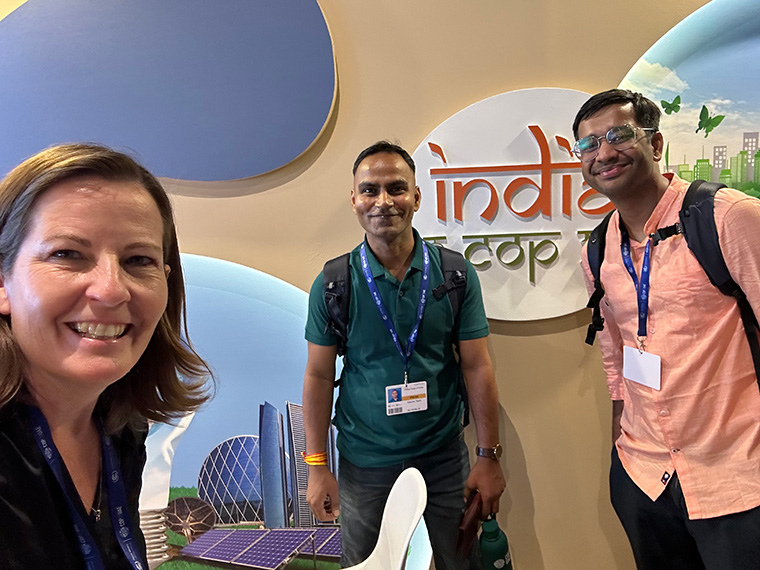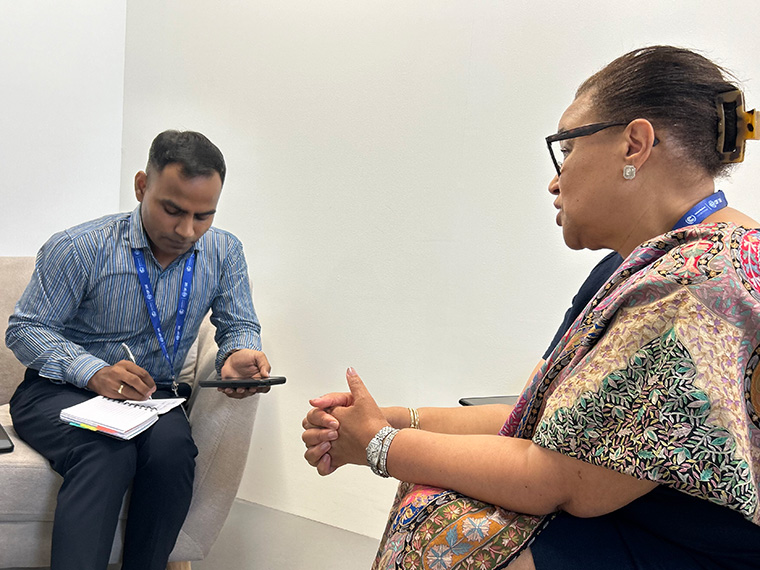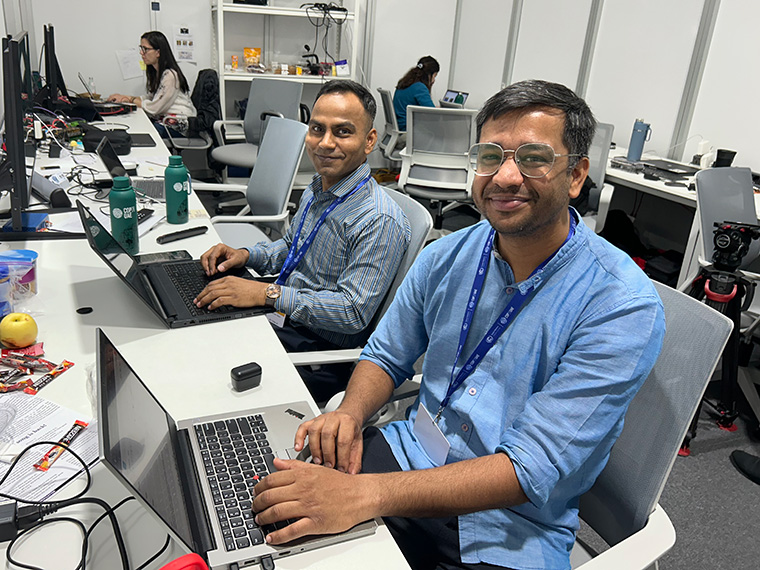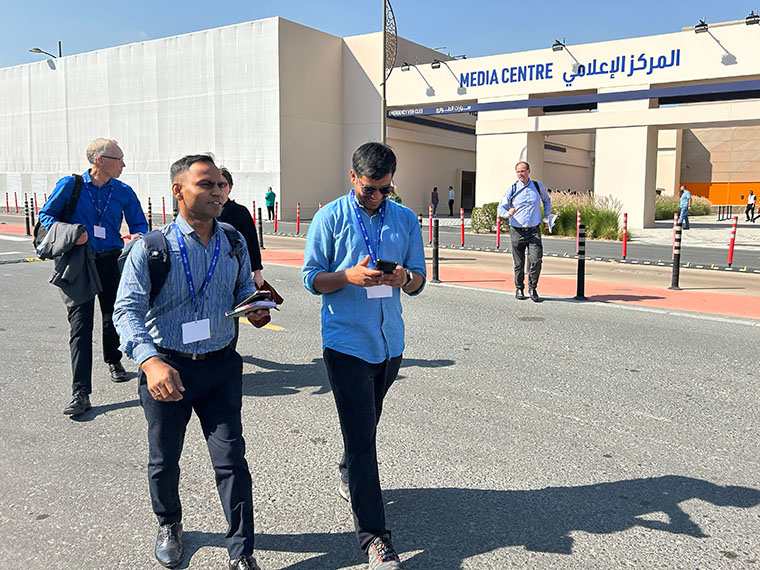



CREDIT: Olivia Zhang
Gaurav Saini (COP28 Fellow) and Sibi Arasu (AP Mentor) reflect on their experiences reporting on the 2023 UN climate change conference, in Dubai, as part of the COP28 India Climate Journalism Fellowship.
COP28 India Climate Journalism Fellow
I am deeply moved and profoundly grateful for the incredible journey I have had. I express my deepest gratitude to those who made this odyssey possible: Barun Jha, my guiding editor at Press Trust of India; the exceptional Associated Press editors Lagipoiva Cherelle Jackson, Peter Prengaman and Dana Beltaji; and the invaluable support from Devon Terrill at the Stanley Center.
Our journey started in Kochi, where I witnessed firsthand the transformative impact of the “India Climate Journalism Program” on how climate stories were told at PTI. I admire the remarkable contributions of energy and climate reporting of Sibi Arasu, an AP reporter in India who was my mentor while a journalism fellow at COP28. I was excited about collaborating with him.
From the start, AP and The Stanley Center’s meticulous planning left me in awe.
Preparations began early, and AP editors entrusted us with a pre-COP story on one of the most critical issues — the operationalization of financial support for communities suffering irreversible damage due to climate change despite contributing little to it.
Sibi’s vast network was instrumental in gathering insights from the best experts on the issue. After at least four revisions over several days, we finally got what we needed and learned a lot in between.

CREDIT: Devon Terrill
The days leading up to COP were a whirlwind of emotions.
Dec. 3 arrived, and as I boarded the flight I had butterflies in my stomach. Stepping into Expo City and collecting my badge for the largest U.N. climate conference, the magnitude of the event hit me.
Devon showed us around and explained the COP venue map like she had been there for years. I was thrilled to see the familiar faces of AP colleagues, Peter, Dana, Seth Borenstein, Alyssa Goodman and Teresa de Miguel again. The energy in the AP room at the media center was electric.
Could this experience get any better? I asked myself. My first on-site COP, collaborating with outstanding climate reporters, editors, and journalists — it felt surreal.
Sharing space with legends like Seth overwhelmed me beyond words.
Adapting to the distinct working cultures and writing styles between PTI and AP was a challenge, but Sibi’s guidance and invaluable advice streamlined my approach.
With each passing day, I found my rhythm. Access to exclusive pressers, courtesy of Sibi, Seth, and another reporter, Jamey Keaten, opened doors to invaluable insights and stories.
Covering global perspectives during the talks expanded my network and enriched my understanding of India and the Global South’s stance in climate negotiations.

CREDIT: Sibi Arasu
I found myself posing questions to representatives and lead negotiators of the EU on the second day of my first climate conference — isn’t that amazing? I am thankful to Devon, who facilitated access to extremely helpful resources like the CCMP Trello board.
Dana, AP’s climate editor, mentored me on why it’s important to simplify things for the wider public who may have limited knowledge on climate change. “Climate change affects everyone; so, everyone should be able to read and understand it,” she said. I couldn’t agree more.
Peter said: “Whatever you have in your head, immediately put it on paper. You will know what you need to do next.” This is a basic rule of reporting, but only a few newsrooms follow it like AP does.
Sibi would say, “Quotes (from scientists and others) should be conversational. These connect common people with the story.”
These words have become my guiding principles.
The journey was punctuated by learning curves — navigating the complexities of the EU’s carbon tax story, receiving feedback that boosted my confidence, and gradually aligning with the AP style.

CREDIT: Devon Terrill
From contributing a few quotes to being part of one of the top 10 stories on AP’s website, this fellowship was transformational for me. With many bylines and an evolving storytelling style, this has been an immersive experience.
To Sibi, mentor and friend, I owe immense gratitude. The aspiration to share this invaluable learning with fellow PTI journalists fuels my enthusiasm.
I am hopeful this program is taken forward and other PTI journalists get an opportunity to work and learn from the best minds in climate journalism.
This experience has been more than enriching — it has been life-changing. To everyone who made this possible, thank you. I carry these memories close to my heart and eagerly anticipate our paths crossing again at the next climate conference.
AP Mentor
As a climate journalist, COPs are important not only as a benchmark of where the world stands concerning climate action but also as the annual event during which climate journalism takes center stage in global news coverage.
Given the importance of this event, I was extremely glad to hear that The Associated Press will be continuing its collaboration with the Press Trust of India to cover the COP. As the AP’s climate journalist in South Asia, I was extremely grateful to hear that I would get an opportunity to work with PTI’s climate and environment reporter, Gaurav Saini, for this customized fellowship.
I met Gaurav during the training program in Kochi in southern India earlier this year and we have continued to keep in touch, given how closely our journalism aligns. The program was an incredible opportunity to continue this effective, exciting professional relationship. I can honestly say from beginning to end, I enjoyed every moment of it.

CREDIT: Devon Terrill
Gaurav was easy to work with, knew his beat—climate and environment—inside out and was highly receptive to feedback about his work.
Throughout the program, with guidance from AP editors, Lagipoiva Cherelle Jackson, Peter Prengaman and Dana Beltaji as well as guidance from Devon Terrill at the Stanley Center, Gaurav and I came up with story ideas to pursue before and during the COP, tracked all related developments from India and our region, and tried to prepare ourselves the best we can to hit the ground running once we reached Dubai for the climate talks.
We collaborated remotely on a story about one of the key issues at the COP, the loss and damage fund, to produce a report on how this fund’s creation will be vital for the climate talks in Dubai to be considered a success.
Given the PTI’s different writing style, there were times when Gaurav had to make adjustments to meet AP style and he was not only receptive to the feedback but from what I could tell, happy for the learning experience. As the program progressed, Gaurav utilized ‘AP style’ with great success.
Editorially too, Gaurav was keen to have discussions and learn more about covering the global story of climate change and trying to use this perspective to shape his nationally-themed stories on the subject. I also noticed that his drafts for PTI were taking an ‘AP Style’, which showed growth and consideration for the work we had done together.

CREDIT: Devon Terrill
As we reached Dubai and began reporting, the assistance and guidance from AP editors and colleagues at the Stanley Center was invaluable. In hindsight, I think their welcoming and positive influence helped us produce the work we did, which I believe is substantial at a total of over 20 stories written by both or either of us and also a dozen contributions by us to AP colleagues’ reports.
Working with Gaurav, we were able to brainstorm on the constant developments at the COP, think through as a unit about how to cover the negotiations both from an India/South Asia perspective as well as a global perspective, and try to prioritize the stories that we felt mattered most. Gaurav’s insights and feedback on ideas was invaluable to me and I couldn’t have asked for a better partner for this program.
As we near the end of this program, I’m confident that Gaurav and I will be in touch for years to come. I hope many other journalists are provided similar opportunities to collaborate as I think this program ranks among the most inspiring experiences in my professional career so far.
I’d like to thank the AP climate team, PTI and the Stanley Center for making this happen. I can definitely say I’m a better climate journalist than I was before the program, with the added icing on the cake of developing a great friendship with Gaurav.